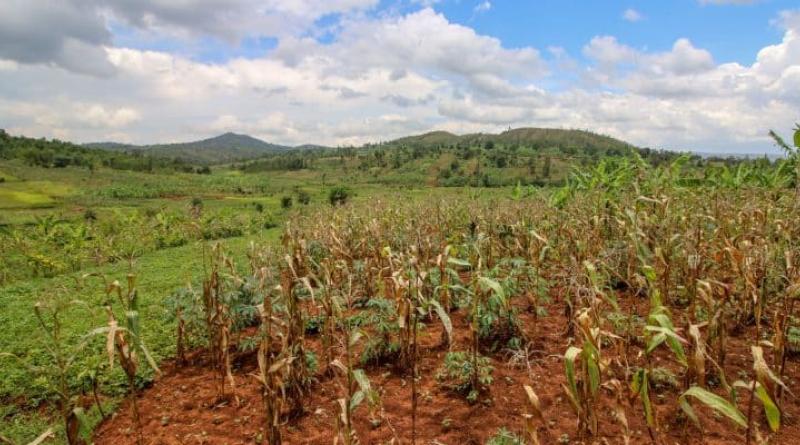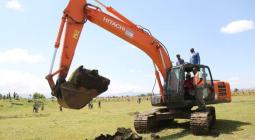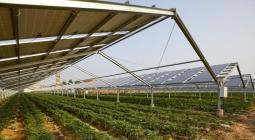AFRICA: Climate puts agriculture with insufficient yields to the test

Droughts and other extreme weather events not only threaten human lives, but also food security. And for a continent like Africa, where agricultural practices are unprofitable, the bill is steeper. In the Horn of Africa, the World Food Program (WFP) estimates that at least 20 million people are at risk of famine due to drought. As an alternative, scientists are proposing agriculture that is profitable, sustainable and climate resilient.
In Africa, food security is further threatened by extreme climatic phenomena, notably droughts and floods. If in the absence of these phenomena, agricultural yields are already insufficient for an ever-increasing population (2.1 billion inhabitants by 2050, according to the United Nations), these yields are even lower, in this marked context by climate change. According to the World Food Program (WFP), at least 20 million people in the Horn of Africa have been at risk of famine since last year due to worsening drought in Kenya. Somalia and Ethiopia.
Addressing the problem of food security requires above all the analysis of agricultural production. It remains one of the determining variables, since it even affects the average food ration per capita. According to the Food and Agriculture Organization of the United Nations (FAO), between 1960 and 2000, per capita food production increased everywhere in the world, except in sub-Saharan Africa. Although the continent holds 12% of the planet's arable land, its share of global agricultural trade has declined from 10% in 1960 to 2% today. Its agricultural trade balance, balanced until 1980, deteriorated due to food imports (rice, oil, wheat).
For the FAO, food crop yields in sub-Saharan Africa are low, particularly due to a lack of organic and mineral inputs. Only around 10 kg of fertilizer per hectare per year, or 20 times less than in industrialized countries and 10 times less than the world average. The same applies to the planting of trees to recycle mineral elements and fix nitrogen in the air, the creation of hill reservoirs, the irrigation of plantations and the reduction of storage losses.
The additional impact of climate
Food security is further compromised in Africa when the consequences of unprofitable agriculture are added to those of extreme weather events.
Droughts, floods, rising sea levels and hurricanes negatively impact human livelihoods. Because these phenomena destroy crops, livestock, fishery resources, ecosystems as well as the infrastructure that underpins agriculture, livestock and fishing, not to mention production facilities such as irrigation systems and shelters for livestock. A phenomenon which manifests itself more acutely in Africa, where warning systems for climate disasters are insufficient. The “State of Africa Climate 2021” report published by the World Meteorological Organization (WMO), indicates that 60% of the African population is not covered by early warning systems to deal with extreme weather events and climate change.
The African Development Bank (AfDB) indicates that more than 90% of African agriculture relies on rainfall. Which makes it the most vulnerable economic sector and the most exposed to climate impacts. The concern is greater when we talk about the ADB's forecasts. According to the financial institution, extreme climatic phenomena such as droughts, floods, heat stress and tropical cyclones will intensify and multiply. In some cases, today's climate extremes may be tomorrow's "normal" weather. Furthermore, rising sea levels will threaten Africa's large coastal population. These impacts will not only jeopardize people's well-being and livelihoods, they will damage the environment and the economy.
More than half of people living in poverty are small farmers. According to the ADB, they provide 80% of the food consumed in the region. This shows how climate change, which hundreds of thousands of African farmers are facing, is weakening local economies and accentuating food insecurity.
It is therefore obvious to African farmers, breeders and fishermen that adapting to climate change means ensuring food security.
Going beyond climate-resilient agriculture
Guaranteeing food security in Africa in the context of climate change should take into account the parameters of productivity, sustainability and adaptation to climate change. FAO believes that much of the solution can be found in the different sectors that make up agriculture, including forestry, fisheries and aquaculture. “ We have a duty to raise awareness of food security and strengthen political commitment at all levels; develop a data analysis on the impacts and opportunities offered to different agricultural sectors and make it available to policy makers and small farmers; strengthen investments, research and development to build resilience and cope with the impacts of climate change that we anticipate ,” explains the FAO.
The Intergovernmental Panel on Climate Change (IPCC) report calls for a model of “adaptation through transformation ” that “ alters the fundamental attributes of a system in response to climate and its impacts.” ". It should nevertheless be noted that today in Africa, there are isolated cases of countries which recognize the benefits of sustainable use of land, profitable and climate-resilient agriculture. This is the case for Ethiopia, Kenya and Rwanda, which have already put plans in place.
In Ethiopia, the government has established the Green and Climate Resilient Economy Strategy. The program aims to help the country reach middle-income country status by 2025 while developing a green economy. Its four pillars are improving harvests and livestock production practices; protection and replanting of forests; increasing renewable energy generation; and a direct shift to energy-efficient technologies for transport, industry and construction.
Kenya's low-carbon climate resilience plan is integrated into the national development plan, Kenya Vision 2030 . The East African country has replaced traditional GDP-based development models with a new model incorporating social dimensions of development progress. Kenyan smallholder farmers are encouraged to adopt climate-resilient agricultural systems such as agroforestry, no-till farming and crop diversification to ensure food security.
Rwanda's climate-resilient green agriculture approach is part of an overall approach that combines sustainable wealth creation and poverty reduction, through sustainable management of natural resources and climate-resilient economic growth. climate and green. This involves reducing poverty, on the one hand by empowering the rural poor, men and women, so that they participate in the transformation of the agricultural sector and rural development, and on the other hand by reducing their vulnerability to climate change. Rwanda had committed to devoting 10% of its budget to agriculture, to ensure growth of 6% in this sector.
In East and West Africa, where the question of food security is acute, experts advise rural communities to adopt mixed crops and terraces. “ This involves in particular crop diversification (corn, vegetables, etc.), better irrigation and easier access to seeds and species most resistant to climate change ,” explains Tamer El-Raghy, the capital fund risk ARAF (Acumen Resilient Agriculture Fund) which operates in several African countries affected by climate change.





